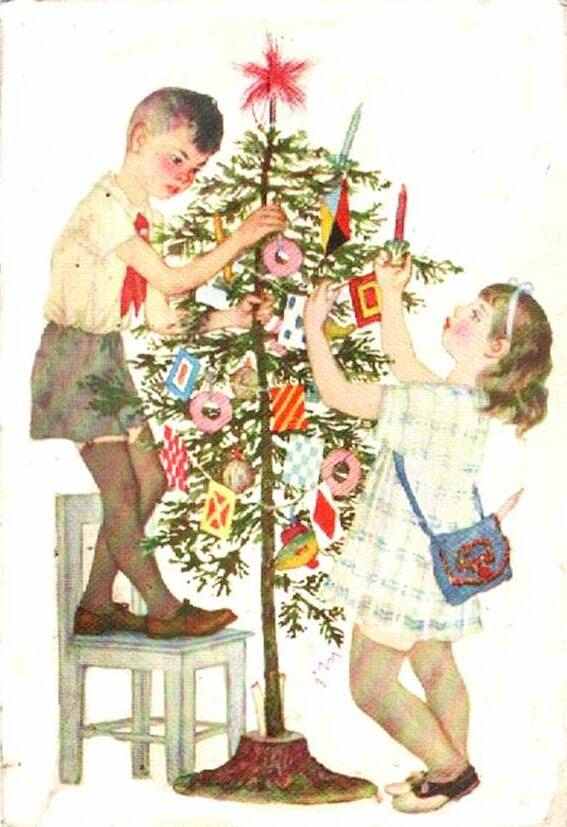
Russian Hosiery: 20th Century Chronology--The 1960s

Figure 1.--This is a Russian postcard mailed in 1964. It looks like a Christmas card, but of course the Soviets discouraged the celebration of Christmas and replaced it with a winter festival. Notice that the star on the tree is red. The boy and girl both are pictured wearing long stockings. Note that the boy is a young pioneer (note the red scarfe). That mens he is at least 9-10 years old.
|
|
We see Russian children wearing a variety of hosiery in the 1960s. Some boys wore knee socks. They were seen as a kind of dressy style. More common were ankle socks. Ankle socks seem to have been the most commonly worn hosiery. They were alsomost universal during the warm summer months. Long stockings were still commonly worn by primary-age children in Russia during the winter. This was the case for most of the 1960s. Long stockings rapidy disappeared in Central Europe during the 1950s. Not only were they seen as old fashioned, but they were replced by tights. This process began in Germany where long stockings had been very common. It also occured in Scandinavia. The Soviet Union and to a lesser extent Polnd, was some of the few countries where long stockings were worn in the the 1960s. Both boys and girls continued to commonly wear them, both with short and long pants. We are not etirely sure about the age of the children wearing them. We think that they were fairly common for children through 10 years of age. We are less sure about older children. This did not begin to change until 1969 when tights were finally introduced.
Hosiery Types
We see Russian children wearing a variety of hosiery in the 1960s.
Knee socks
Some boys wore knee socks. They were seen as a kind of dressy style.
Ankle socks
More common were ankle socks. Ankle socks seem to have been the most commonly worn hosiery. They were alsomost universal during the warm summer months.
Long stockings
Long stockings were still commonly worn by primary-age children in Russia during the winter. The post card here illustrates the seasonal nature of long stockings (figure 1). This was the case for most of the 1960s. Long stockings rapidy disappeared in Central Europe during the 1950s. Not only were they seen as old fashioned, but they were replced by tights. This process began in Germany where long stockings had been very common. It also occured in Scandinavia. The Soviet Union and to a lesser extent Poland, was some of the few countries where long stockings were worn in the the 1960s. Both boys and girls continued to commonly wear them, both with short and long pants. We are not etirely sure about the age of the children wearing them. We think that they were fairly common for children through 10 years of age. We are less sure about older children. A reader writes, This illustration gives us important new information about long stocking and hose supporter conventions in 1964 in the Soviet Union. Notice that the garter clasps show under the lad's short trousers and that there are two single straps for each leg rather than the double-pendant Y-shaped garters that were so common in the United States. The boy is undoubtedly wearing a bodice with two garters on the side (like the one faceing in the illustration) and two others in front (clearly implied by the position of the stocking top on the other leg). HBC has had a good deal of discussion from German readers about whether it mattered to boys that garter attachments would show under short trousers. Here, obviously, it is a matter of no concern to the boy. Notice also that the color of the long stockings is brown--probably the commonest color along with grey. The illustration is also useful for suggesting the usual length of long stockings in 1964." HBC is not sure our reader is correct in saying that the stocking supporter straps were of no concern to boys. This is a drawing. Of course age was a factor, but we suspect that Russian boys had many of the sae concerns expressed by German readers.
Tights
The popularity of long stockings during the winter did not begin to change until 1969 when tights were finally introduced. Thus we only see tights at the end of the decade. They did not become widely worn until the 1970s.
Young Pioneers
A reader noted the Young Pioneer scarf the boy here is wearing. "It just occurred to me that for the post card here pertains to the subject of hosiery worn by Young Pioneers. But is this boy in uniform or just wearing the red scarf of the
uniform? Maybe a bit of discussion here might be in order. Also the picture is quite seasonal." As to the Young Pioneers and uniform, that is a complicated topic. The Pioneers were a school based program. Thus the school uniform and Pioneer uniform was essentially the same. The key item was of course the scarf. Thus when there was no school uniform the children wore the scarf with their regular clothes. I think that is what is pictured in the card here.
HBC

Navigate the Boys' Historical Clothing Web Site:
[Introduction]
[Activities]
[Biographies]
[Chronology]
[Clothing styles]
[Countries]
[Topics]
[Bibliographies]
[Contributions]
[FAQs]
[Glossaries]
[Images]
[Links]
[Registration]
[Tools]
[Boys' Clothing Home]
Navigate the Historic Boys' Clothing Russian pages:
[Ballet]
[Children's literature]
[Choirs]
[Fashion magazines]
[Movies]
[Royalty]
[School uniform]
[Youth groups]
Navigate the Boys Historical Clothing Web Site:
[Return to the Main Russian 20th century hosiery chronology page]
[Return to the Main Russian hosiery chronology page]
[Return to theMain country page]
[Australia]
[Canada]
[England]
[France]
[Germany]
[Ireland]
[Italy]
[Mexico]
[New Zealand]
[Poland]
[Russia]
[Scotland]
[United States]
Created: 7:21 AM 4/23/2008
Last updated: 7:21 AM 4/23/2008



